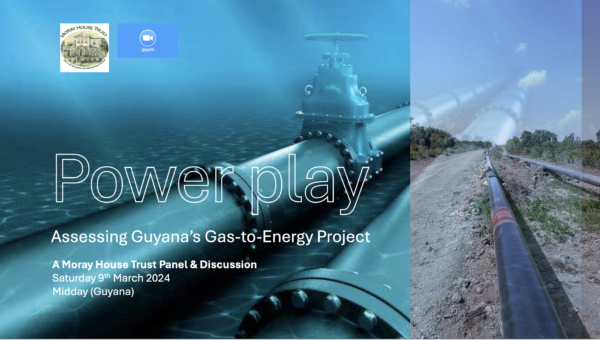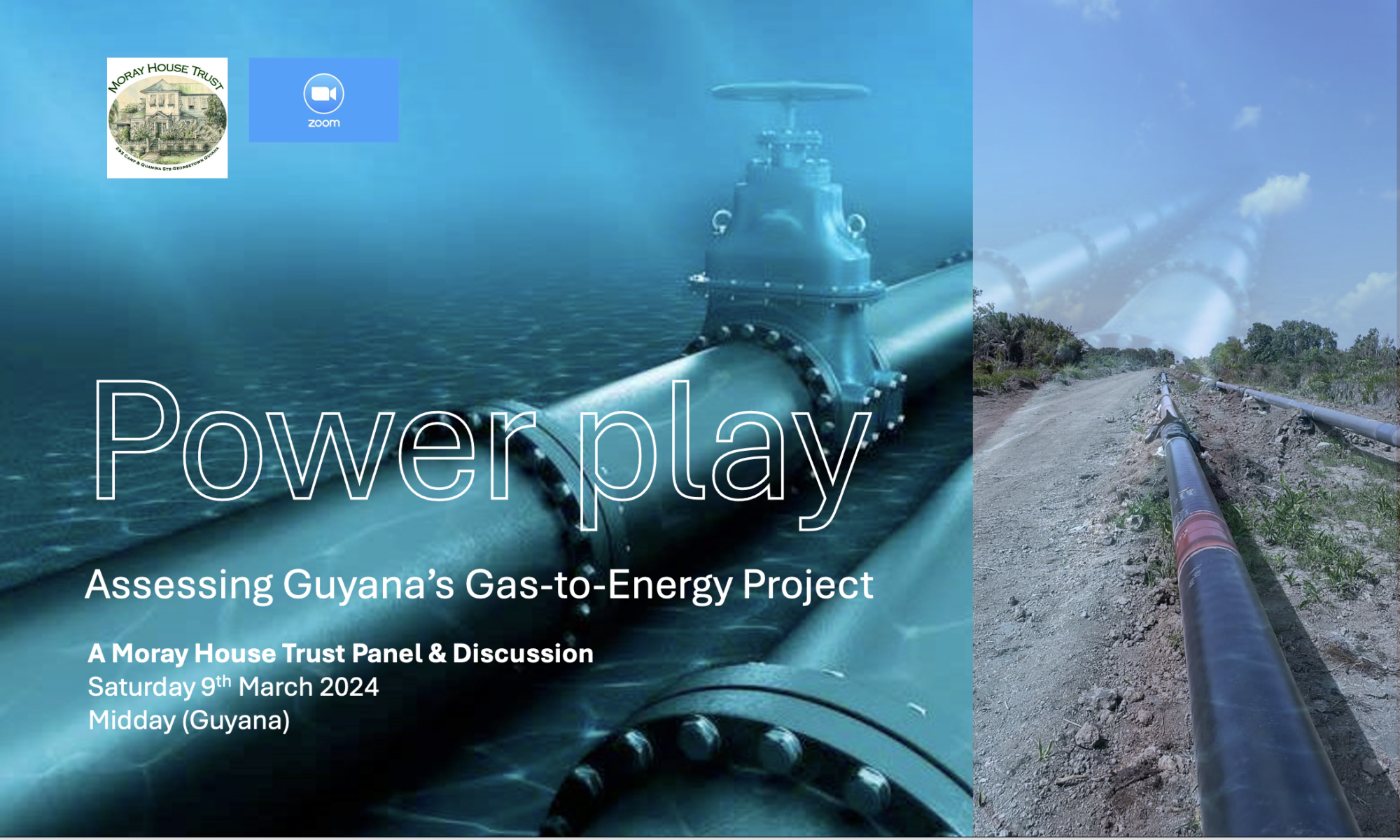Activity: Panel and discussion
Host: Moray House Trust
Date: Saturday 9th March 2024
Time: Midday (Guyana)
YouTube: https://youtu.be/QcpuJwESAOc

MHT has hosted earlier panels to consider the effects of the nascent petroleum and gas industries on the environment (June 2022) and to discuss the pros and cons of the gas-to-energy project (December 2021). Moray House Trust hosts these panels in the belief that a culture thrives and develops where ideas circulate and are robustly debated and interrogated.
The participants were Dr Thomas Singh and Mr Rawle Lucas. Dr. Thomas Singh is the Director of the University of Guyana GREEN Institute (UGGI) and Senior Lecturer in the Department of Economics. Mr Rawle Lucas is also an economist at the University of Guyana and former Chairman of GRA and GPL.
Elizabeth Deane-Hughes was the host.
Activity: Panel and discussion
Host: Moray House Trust
Date: Saturday 9th March 2024
Time: Midday (Guyana)
Platform: Zoom
SYNOPSIS
See: Introductory clip: https://youtu.be/JsUTSn8374U
The Gas-to-Energy project is now expected to cost in excess of USD 2 billion.
It will be the largest project ever undertaken by the Guyana state.
There is still a marked absence of consensus that it is the optimal choice for Guyana. Rawle Lucas began with a look back at another project, the co-generation plant in Skeldon.
Dr Thomas Singh assessed two reports:
1) Guyana Gas to Energy Project is Unnecessary and Financially Unsustainable (Institute for Energy Economics and Financial Analysis):
https://ieefa.org/resources/guyana-gas-energy-project-unnecessary-and-financially-unsustainable
2) The Guyana Gas Monetization Strategy (draft): https://petroleum.gov.gy/sites/default/files/2023-10/Draft%20Guyana%20Gas%20Monetization%20Strategy.pdf
VIDEO CLIPS:
Introductory clip: https://youtu.be/JsUTSn8374U
Power Play: Assessing Guyana’s Gas-to-Energy Project: https://youtu.be/QcpuJwESAOc
Questions for Exxon Mobil: https://youtu.be/Ps_tEQzLGSg
CONVENOR’S COMMENT:
Moray House Trust began to organise panels in 2015 when the sugar industry was in peril. Since then we have hosted dozens of panels on sugar, oil, gas, the constitution and much else.
Our aim is simple: to facilitate public discourse.
In Guyana, unfortunately, this is not a straightforward task.
On Friday 1st March we invited Exxon to participate in today’s panel to give a 10 minute talk, responding to a few general questions about their role in the project and in gas extraction and refining generally.
On Friday 8th March, after multiple follow ups and requests for confirmation, Exxon emailed to ‘respectfully decline the opportunity due to scheduling conflicts’. They had presumably spent the intervening time canvassing each of their ‘staff of several hundred’ individually and by pigeon post.
Exxon is, arguably, within their rights to decline an invitation from Moray House Trust or any other civil society organisation. Indeed, according to their employee, they receive a deluge of these ‘requests’ each week.
However, there are a few points to be made:
1) The way they behaved in this instance verged on the dismissive. It suggested a measure of arrogance or contempt: the large corporation toying with the tiny non-profit. It’s a well- worn tactic to keep these invitations pending until the last possible moment and then duck out. We have endured this sort of playground politics since we started this process almost a decade ago. Our patience is wearing thin.
2) There are broader issues at stake. A Moray House Trust panel, or indeed any panel worthy of the name, is designed to offer a variety of perspectives. If major players like the government or the lead actor in a billion-dollar public project repeatedly refuse to engage, the discussion is skewed. Failure to engage perpetuates a bifurcated discourse of boosters and naysayers. Positions become entrenched and calcify. This does little to advance public discourse. And, by the way, we have now conducted these panels across several political administrations and the failure to engage has been a feature common to each.
In future, when organising panels, we will continue to reach out to groups, corporations and government agencies who might be able to shed light on a particular topic because that is
the proper way to proceed. However, where we repeatedly encounter refusals or last minute regrets, we will also prepare, as we have done today, a list of questions arising for public dissemination.
Whatever it takes, the discussion will continue.
[Isabelle de Caires, Chair, Trustees, Moray House Trust, 9th March 2024]
See: Questions for Exxon Mobil: https://youtu.be/Ps_tEQzLGSg
REVIEW OF THE PANEL AND Q&A
The first presentation attempted to offer a comparative analysis between a previous energy project (the Co-generation Plant at Skeldon) and the Gas-to-Energy Project. Mr Lucas acknowledged the delicacy of the task given that the former is near the end of its project cycle and the latter is at the beginning. He noted that:
1) despite a chequered history in energy projects (at best), Guyana has significantly scaled up each new energy project proposal (Skeldon, Amaila, GTE).
2) each project relies on a different energy source.
3) the unit cost of each project (measured by MW) has increased. It was USD 1.7M per MW for the cogeneration plant, USD 6.1M per MW for the hydropower plant and USD 8.3M per MW for the GTE.
Dr Singh, echoing the IEEFA report (Guyana Gas to Energy Project is Unnecessary and Financially Unsustainable), noted that under the current plans, Guyana would generate 300 MW from the GTE, 214 MW from the conversion of GPL’s existing plants to use gas and 620 MW from hydropower.
He also noted, as the IEEFA report did, that a convenient outcome of the GTE project is that it will solve Exxon Mobil’s problems with flaring of gas. He pointed out that, for example, on November 23rd 2023, 135 MMscf was flared, more than double the daily projected gas pipeline supply of 50 MMscf. Dr Singh further remarked that, should oil prices collapse, natural/associated gas could perhaps become a joint product. Reviewing Guyana’s Gas Monetization Strategy, GGMS (draft), he noted that, while it set out to consider all the potential by-products from gas, it seemed to focus solely on the Gas-to-Energy project. Dr Singh pondered whether the GGMS was an illustration of Say’s Law; the expectation that supply will create its own demand.
The discussion phase lasted for almost an hour, an indication of the complexity of the topic and the range of concerns. One speaker highlighted the absence of a comprehensive comparative feasibility study of all possible energy sources (gas, hydro, solar, wind, etc), which makes it difficult to assess the ‘value’ of each. Another noted that it was not the concept of cogeneration that was flawed – as this has proven to be a success in sugar factories in India and elsewhere – but the implementation at Skeldon may have been faulty. An engineer asked what would happen in the event of a leak or rupture in the gas pipeline: what amount of gas would be stored onshore to offset this risk, what alternative energy supplies would be held in reserve. Mr Lucas stressed that it was vital to ensure that the contracts governing all of these arrangements are robust. Dr Singh felt that Guyana could have made more use of our neighbour Brazil’s expertise in biotechnology. Several speakers called for more strategic thinking in the country’s policy making.
RESOURCES SHARED BY THE AUDIENCE
1: K& M Advisors, Gas to Power Feasibility Assessment in Guyana (2019):
https://nre.gov.gy/wp-content/uploads/2021/04/Gas-to-Power-Feasibility-Assessment-in-Guyana-min.pdf
2: TERMS OF REFERENCE (TOR) / STRATEGIC ENVIRONMENTAL & SOCIAL ASSESSMENT (SESA) (2019)
https://documents1.worldbank.org/curated/en/588071544166223527/pdf/P166730-Guyana-TOR-SESA-FINAL.pdf
3: Gas to Power and Implications for Economic Diversification in Guyana (2022):
https://guyanabusinessjournal.com/2022/03/gas-to-power-and-implications-for-economic-diversification-in-guyana/
4: Guyana’s 1.9 billion gas-to-power project delayed to 2025
https://www.reuters.com/business/energy/guyanas-19-billion-gas-to-power-project-delayed-2025-2024-02-20/

